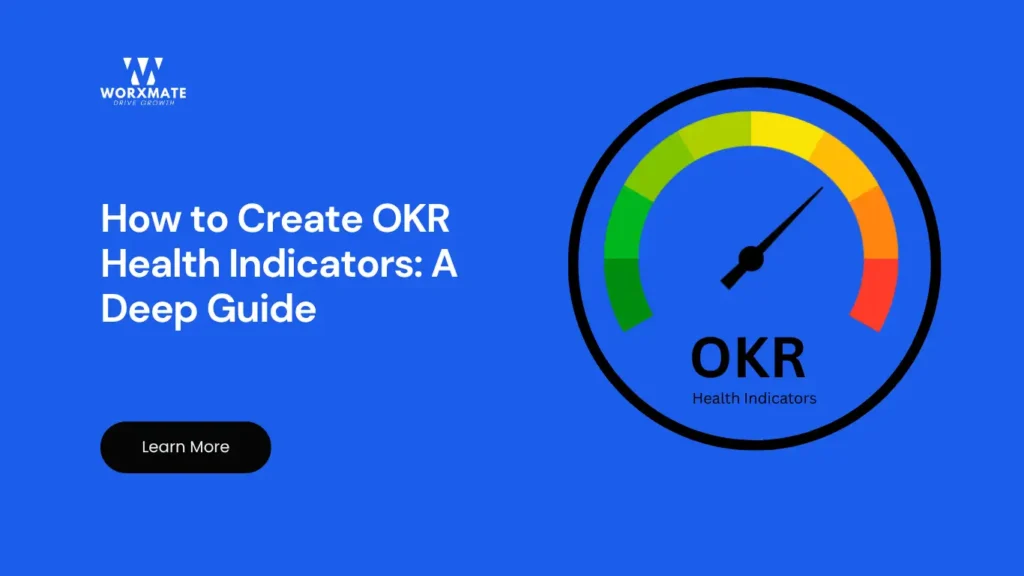Summary
OKR health indicators are specific metrics that measure the progress and effectiveness of your objectives and key results. They provide valuable insights into how well your team or organization is performing against set goals, helping you track progress, identify potential issues, and make informed decisions to stay on course toward achieving your strategic objectives.
The Power of OKR Health Indicators
In today’s fast-paced business environment, setting clear objectives and key results (OKR) is essential for driving progress and achieving success.
However, establishing OKRs is only part of the equation. To truly gauge the effectiveness of your OKRs and ensure they’re delivering the intended results, you need robust health indicators that provide real-time insights into their progress and success.
These indicators act as vital signs for your organization’s strategic initiatives, allowing you to diagnose issues early, make timely adjustments, and keep your teams aligned and motivated toward achieving ambitious goals.
Whether you’re new to OKRs or looking to enhance your existing framework, understanding how to create effective OKR health indicators is crucial for transforming your goal setting process from a periodic exercise into a powerful driver of continuous improvement and organizational success.
What Are OKR Health Indicators?
OKR health indicators are specific metrics used to measure the progress and effectiveness of your objectives and key results. Unlike the OKRs themselves, which focus on what you want to achieve, health indicators tell you whether your OKR process is working properly.
They provide valuable insights into how well your team or organization is performing against set goals and act as a diagnostic tool, enabling you to adjust strategies and ensure you’re moving in the right direction.
Why OKR Health Indicators Matter
Implementing OKRs isn’t just about setting ambitious goals—it’s about ensuring the process itself supports success.
Health indicators help you track progress, identify potential issues before they become problems, and make informed decisions to stay on course.
They provide transparency across the organization, foster accountability, and ensure that your OKR program remains effective and aligned with your strategic vision.
Four Key Characteristics of Healthy OKR Programs
According to Microsoft’s OKR consultants who have worked with dozens of customers, there are four essential characteristics that define a healthy OKR program:
-
Adoption
A healthy OKR program thrives when it’s available to all employees, from senior leadership to individual contributors.
Adoption begins with strong buy-in from leadership and has a key “bottom-up” component as individuals see value and adopt OKRs.
Leaders should demonstrate how embedded OKR tracking is in the organization and integrate OKRs into the existing rhythm of business.
Recommended metric: Percentage of teams that have created OKRs.
-
Engagement
After establishing adoption and providing access to a goal-setting platform, driving engagement becomes crucial.
Users should actively view and check on their goals on an ongoing basis, which gives visibility and awareness of goals across the organization.
Recommended metric: Percentage of check-ins in the last 28 days.
-
Focus
As engagement increases, teams begin to leverage OKRs to focus on what matters—and say no to what doesn’t. In a healthy OKR program, employees should come to work knowing the top 3-5 things to work on and how those align with the overall company strategy.
Recommended metric: Average number of objectives per team (aim for 3-5).
-
Efficiency
A well-designed OKR process should balance thoroughness with speed. Long preparation times may indicate overly complex processes, while too short a time might result in poorly defined or unrealistic objectives.
Recommended metric: Time spent on the OKR cycle and preparation.
How to Create OKR Health Indicators: Step-by-Step Guide
-
Define Your Objectives Clearly
The first step in creating OKR health indicators is to define your objectives clearly. Objectives should be ambitious yet achievable, specific, and aligned with your organization’s overall mission and strategy.
Clear objectives provide a focus for your efforts and serve as the foundation for developing key results and health indicators.
Tips for Defining Objectives:
-
- Be specific and use precise language to describe what you want to achieve
- Ensure objectives are ambitious but realistic
- Align objectives with your organization’s mission and strategy
-
Establish Measurable Key Results
Once you’ve defined your objectives, establish measurable key results that will indicate progress toward those objectives. Key results should be specific, quantifiable, and time-bound, providing clear metrics for success.
Characteristics of Effective Key Results:
-
- Quantifiable and measurable
- Time-bound with clear deadlines
- Challenging but achievable
-
Select Relevant Health Metrics
After establishing your OKRs, select relevant health metrics that will help you track the effectiveness of your OKR program. These metrics should provide insights into adoption, engagement, focus, and efficiency.
Examples of Health Metrics:
-
- Percentage of teams with defined OKRs
- Frequency of OKR check-ins
- Alignment score between team and organizational objectives
- Time spent on OKR-related activities
-
Create a Regular OKR Tracking Cadence
Establish a regular cadence for tracking and reviewing your OKRs and health indicators. OKR check-ins should be conducted weekly, with more comprehensive reviews done quarterly.
Best Practices for OKR Check-ins:
-
- Keep meetings brief (15-20 minutes)
- Reflect on last week’s progress and learnings
- Discuss OKR scores and confidence levels
- Plan priorities for the upcoming week
-
Implement a Dashboard for Visualization
Visualizing your OKRs and health indicators through a dashboard can significantly enhance understanding and engagement. A well-designed dashboard provides a clear picture of your OKR status, including progress, key result updates, and activities.
Elements of an Effective OKR Dashboard:
-
- OKR progress indicators showing if objectives are on track
- Key results update frequency tracking
- Activities associated with key results and their status
Case Study: Microsoft’s OKR Health Transformation
Microsoft has been at the forefront of implementing and measuring OKR health indicators across its organization. According to a study by Microsoft’s OKR consultants, organizations that effectively track their OKR health see a remarkable improvement in performance compared to those that don’t.
Microsoft found that companies with high employee engagement in their OKR programs achieved a 25% increase in productivity due to greater alignment with business goals. This engagement was directly correlated with regular check-ins and transparent progress tracking.
The company implemented a comprehensive OKR health dashboard that tracked four key metrics: adoption, engagement, focus, and efficiency.
By monitoring these indicators, Microsoft was able to identify areas where teams were struggling and provide targeted support.
According to McKinsey research, organizations with robust goal-setting frameworks like OKRs saw a 27% improvement in productivity.
Furthermore, companies that maintained healthy OKR programs were more than twice as likely to outperform their peers in financial performance.
How Worxmate Enhances Your OKR Health Indicators
Worxmate’s AI-powered OKR Software transforms how your teams set, track, and achieve goals with intelligent health indicators. Our platform addresses the common challenges of OKR implementation, including ensuring objectives are clearly defined, aligning multiple teams, tracking progress in real-time, and executing effectively.
Worxmate’s DEEP (Define, Execute, Evaluate, Plan) strategy-focused AI product nurtures your progression from considering objectives to realizing key results. Our platform offers:
- AI-driven insights to ensure fair, objective, and transparent assessments
- Real-time health indicators that forecast goal achievement and identify at-risk objectives
- Streamlined alignment across teams with quick adaptation and execution capabilities
With Worxmate, you’ll experience less time spent on goal-setting, greater alignment between team and company goals, and increased goal achievement rates.
Ready to transform your OKR process with powerful health indicators? Book a Demo with Worxmate today and see the difference our AI-powered platform can make for your organization’s performance management.
Conclusion
Creating effective OKR health indicators is essential for ensuring the success of your objectives and key results framework.
By defining clear objectives, establishing measurable key results, selecting relevant health metrics, creating a regular tracking cadence, and implementing visualization tools, you can gain valuable insights into the progress and effectiveness of your OKRs.
Remember that OKR health indicators are not just about measuring performance—they’re about fostering a culture of transparency, accountability, and continuous improvement.
With the right health indicators in place, you can identify potential issues early, make informed decisions, and keep your organization aligned and focused on achieving its strategic goals.
Whether you’re just starting with OKRs or looking to enhance your existing framework, investing in robust health indicators will pay dividends in improved performance, engagement, and results.



